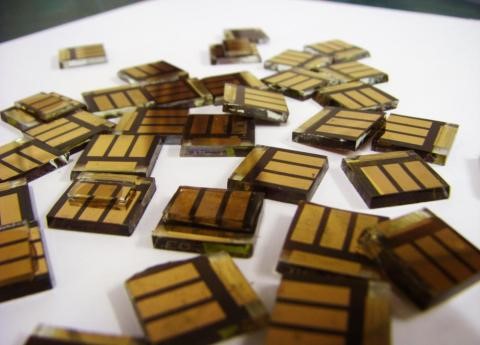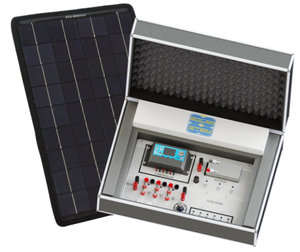|
Solar energy is one of the few sources of energy that produces no carbon emissions and has the most potential for mass adoption. Solar power has been gaining momentum this past decade with the cost of solar panels dropping 60% since 2010. However, solar panels still face road blocks, like high cost, low efficiency, and space necessity, that make its future hard to predict. Figure 1. 70,000 solar panels on Nellis Air Force Base (U.S. Air Force photo by Airman 1st Class Nadine Y. Barclay) There has been a great effort in research and development in the past few years to create a more efficient and cost-effective solution. The solar panels currently being distributed are solar photovoltaic (PV) cells. They are difficult to manufacture, which is a big contributor to their high cost, and they are not as efficient, turning only 20% of light received into energy. However, there has been a new breakthrough in solar energy research from a mineral called perovskite. Figure 2. Perovskite Mineral, with pen for scale (USGS) Perovskite is an amazing breakthrough in solar research, it can be made into an ink solution and painted or printed on objects to allow those objects to generate power. This means that all surfaces could potentially generate power! The use of perovskite will drive the costs normally associated with solar panels significantly down, which means perovskite may lead to a more affordable solar energy option. This mineral is more efficient than the traditional solar panels used today, with a 22.7% efficiency rate and a theoretical maximum efficiency of 40%. Also, because this material is so thin we may be able to paint it onto existing solar panels to increase the overall efficiency. Figure 3. Perovskite tin solar cells (Oxford University Press) The draw backs of this mineral however involve the fragile nature of the material and its life span. Where traditional solar panels have a lifespan of years, this new material degrades in hours and days. This is one of the areas researchers are currently focusing. Extending the life span of perovskite panels would mean a cost effective alternative to expensive solar panels. What can we expect in the future? 1. As more research and development is invested into solar technology there may be smaller, more efficient, and cost-effective solar panels in our future. 2. It’s possible we may see solar farms in space. The Japan Aerospace Space Agency is looking into putting solar panels on planets closer to the sun and transmitting the energy back to us on earth. 3. We may also be seeing solar cars in our future. Lightyear One, is a Dutch solar-powered car that is planning to produce the first 10 models in 2019. 4. Tesla’s SolarCity has been working on roof tiles with solar panels embedded in them for a more modern look to the traditional flat black solar panels. Figure 4. Tesla Solar City roof tile (Tesla/SolarCity) 5. A French company, Ciel & Terre International, is working on floating solar panels for countries that don’t have the space solar panels require. They started their work in 2011 and are continuing to make progress towards a floating solar panel. Ready to go solar? There are plenty of solar panel options for you! You can purchase solar panels for your own home after consulting with experts. If you have a child, you can contact their school to see how they are teaching your child and their generation about solar energy. Our solar4STEM 200 and solar4STEM 50 are perfect for educating kids about solar energy in an interactive way that kids love. Click Here to learn more.
What do you think the future has in store for solar? Let us know what you think in the comments below!
0 Comments
|
Make STEM Fun & Easy!Located in Pinellas Park, FL, solar4STEM has been providing parents and educators interactive STEM kits to keep kids engaged. Let us help you make STEM fun & easy with hands-on experiments!
Follow Us3845 Gateway Centre Blvd.,
Suite 360 Pinellas Park, FL 33782 Vertical Divider
|
Vertical Divider
|
|
|
Sitemap
|







 RSS Feed
RSS Feed



